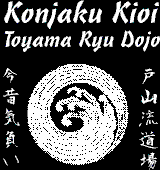 |
Toyama Ryu Batto Do Konjaku Kioi Dojo (Ancient and Modern Fighting Spirit Dojo) |
5980 66th St N Suite M St Petersburg FL 33709 Email: info@toyama-ryu.com Phone: 727-329-9679 |
|
Home
|
Surface PolishThe surface polish of a katana is as important to cutting as the geometry. It is especially important for the durability of the edge and surface friction of the blade. An edge from a coarse grit stone may feel very sharp and cut well for the first few times, but it will quickly become dull. A rough finish will also bind up in the target. Polishing and sharpening a katana are the same process. For swords that will see real use, a full cosmetic polish is not needed. Who wants to pay $2000 every year to keep your sword sharp. A sharpening polish leaves some scratches on the surface and skips the purely cosmetic steps. The dojo store offers full sharpening, repair, and customization services to keep your katana in top working order. It also has a wide range of Japanese Water Stones and holders. GritThe first thing everyone asks is what grit stones are used to polish or sharpen a sword. What could be easier than selecting an abrasive? Is that US, European, English, or Japanese grit? Are you specifying the mesh used to separate the particles or the particle size. Everyone uses a different standard and they don't compare well. Here is the results of my research into grit. Equivalent Grit Table
If a sword just needs to be touched up, I use six progressively finer grits from 800 to 12000 (Japanese). The polished surface is degraded if the edge is touched up with anything coarser. Water StonesJapanese water stones are either natural and artificial. Natural stones can be quite expensive, but artificial stones can be used for sharpening polish. About half the stone used in a full cosmetic polish can also be artificial, but some steps require specific natural stones. Artificial stones use a graded abrasive suspended in either a clay or ceramic media. The stones use water as a lubricant. A series of stones ranging from about 800 to 12000 grit are used to sharpen blades in good shape. If a blade is badly shaped or has chips to remove, stones down to 80 grit can be used. Water stones should be soaked for 15 minutes before use. Mixing baking soda in the water will help reduce corrosion of the blade during sharpening. The dojo store offers a wide range of Japanese Water Stones. |
Copyright © 2006 by Konjaku Kioi Toyama Ryu Dojo, All rights reserved.
Samurai Swords
Iaito (Practice Swords)
Shinken (Cutting Swords)
Wakizashi (Short Swords)
Tanto (Daggers)
Japanese Weapons
Maintenance
Uniforms
Sharpening
Sword Repair
Martial Arts
Dictionary Your Name in Japanese
Dojo Stories
Tatami Targets
